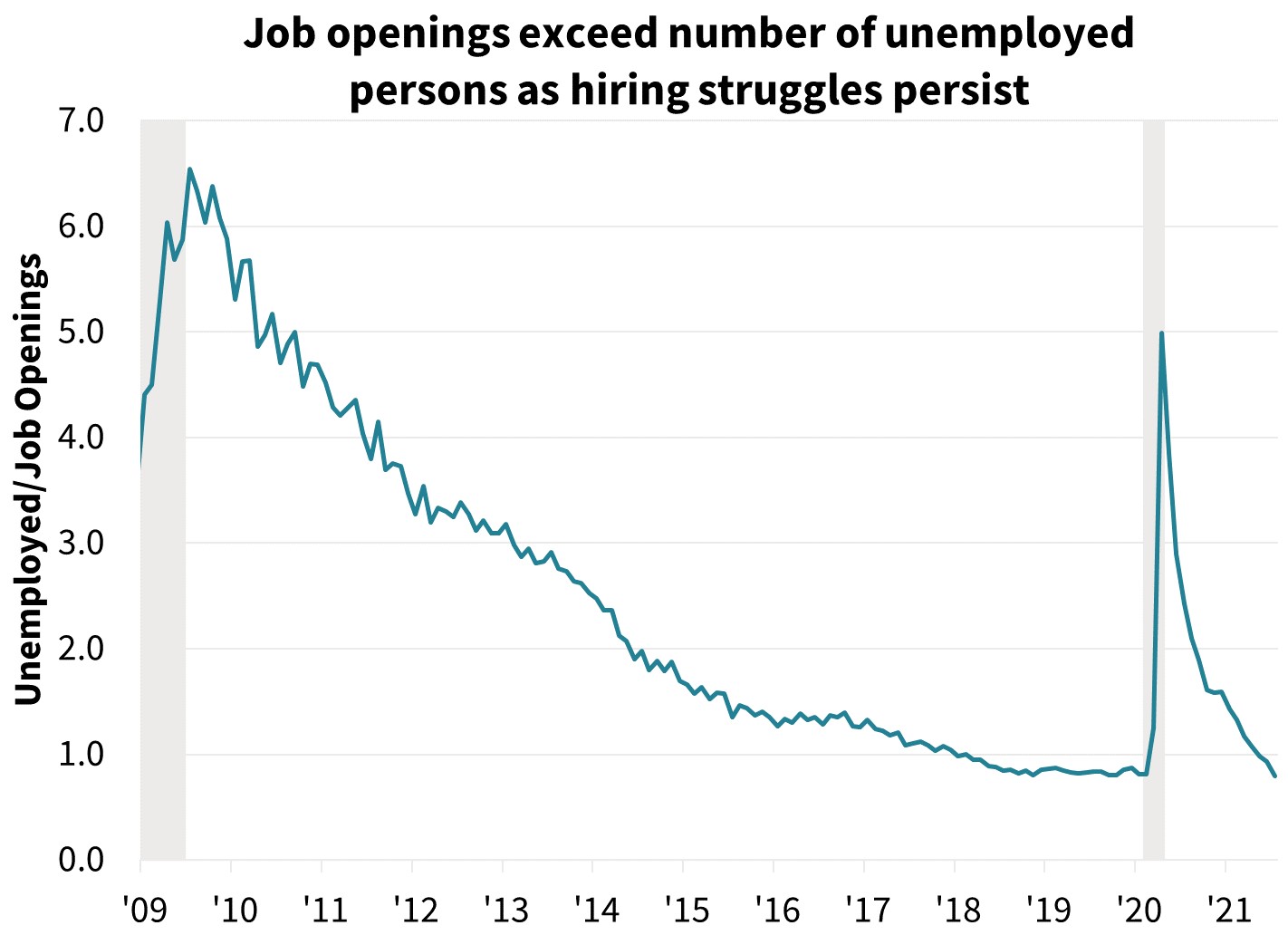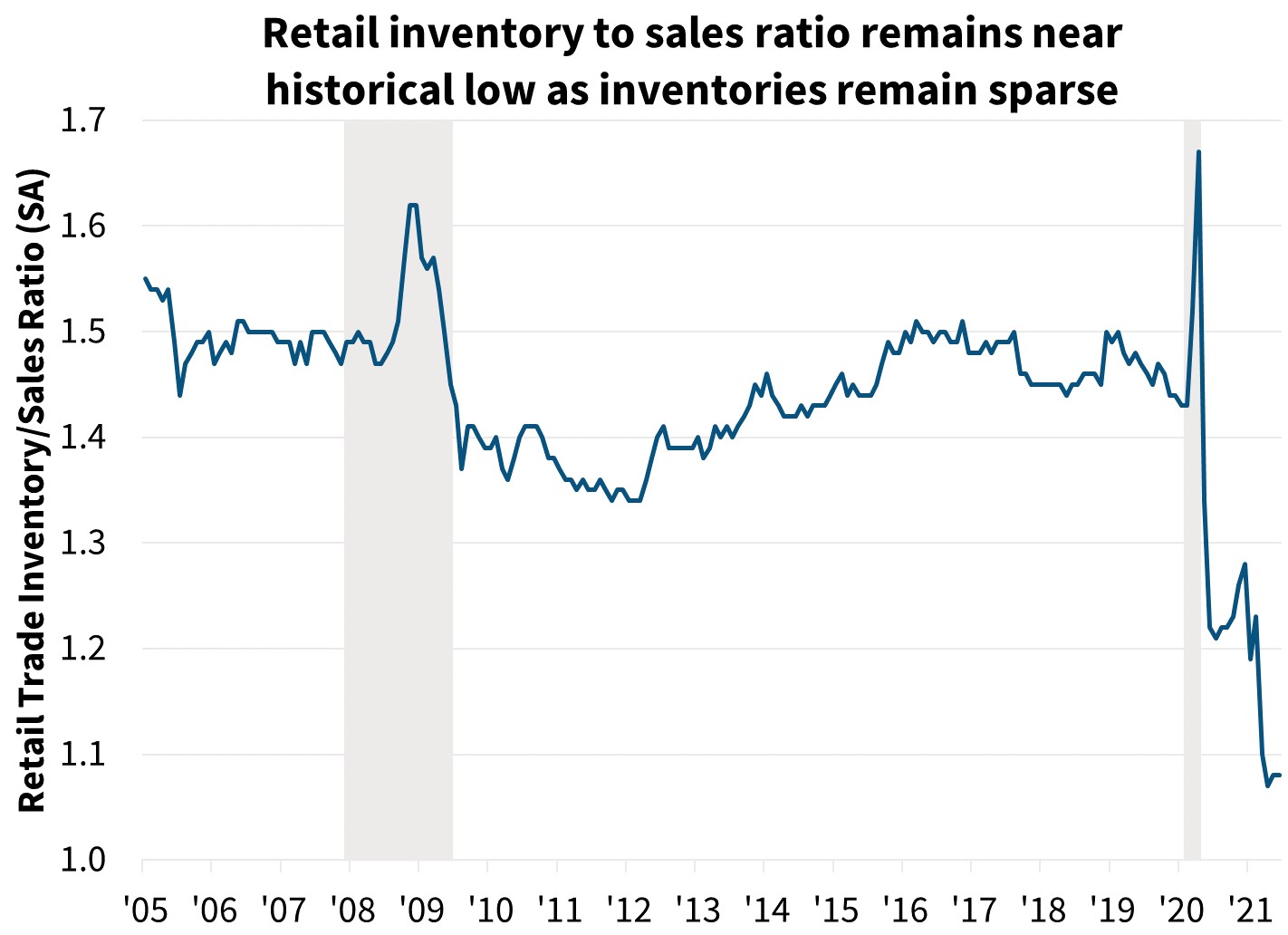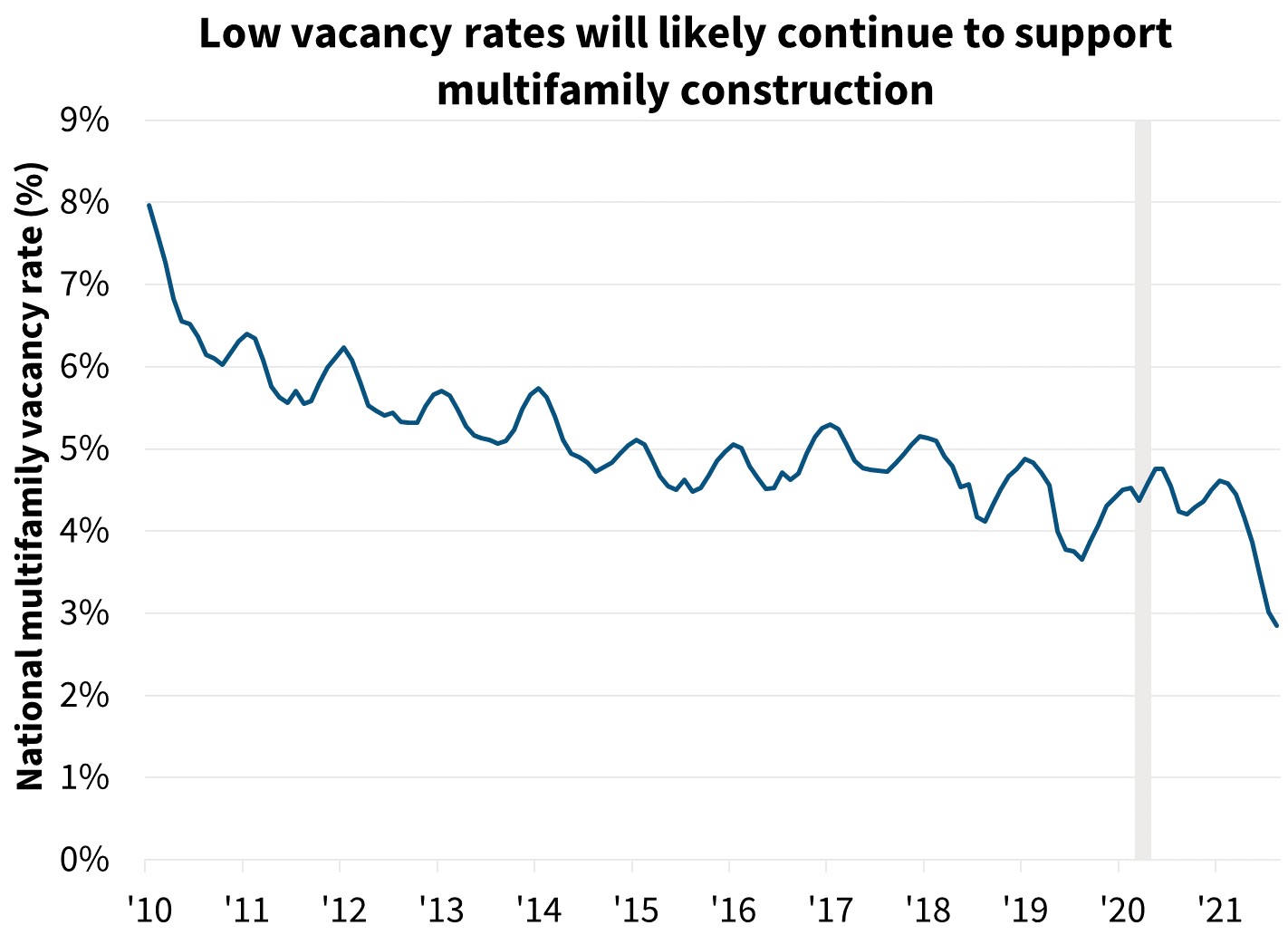Continued Supply Constraints Inhibiting Economic Growth and Housing
We revised downward our forecast for 2021 real gross domestic product (GDP) from 6.3 percent to 5.4 percent on a fourth quarter-over-fourth quarter (Q4/Q4) basis, while we revised upward our growth outlook for 2022 to 3.8 percent from 3.2 percent. These revisions reflect the persistence of supply chain disruptions and labor market tightness that are, in part, due to continuing COVID-19 dynamics, pushing more of our growth projection into a later time frame. Although we expect these constraints to lessen over time, they are likely to drag significantly on economic activity well into 2022 and exert additional upward pressure on prices. Additionally, we have revised upward our inflation outlook through mid-2022. As measured by the Consumer Price Index (CPI), we forecast annual inflation to end 2021 at 5.4 percent and remain above 5 percent until the second quarter of 2022, and we project the Federal Reserve’s preferred measure of inflation, the PCE deflator, to be 4.6 percent at year end. While we do expect substantial deceleration later next year, we anticipate inflation to remain elevated, with the core CPI and core PCE both remaining near 3 percent through our forecast horizon.
In our view, the principal risks to our economic forecast come from the varying responses of consumers, the labor market, and policymakers to the evolving health risks created by the pandemic, as well as the related speed at which global supply chain disruptions are resolved. Additionally, we have not yet incorporated any potential fiscal package into our outlook due to uncertainty over details and timing. Still, regarding the infrastructure bill passed in the Senate, due to a limited net change in expenditures through 2022 and considering that infrastructure benefits typically occur over the long run, we expect only a minimal impact on our outlook. In contrast, the much larger proposed budget reconciliation bill could have a meaningful impact. The key additional risk to our housing forecast is a possible rise in mortgage rates precipitated by a more persistent increase in inflation or inflation expectations.
The Labor Market Will Be Key
The August employment report was disappointing. While the unemployment rate fell two-tenths to 5.2 percent, only a net 235,000 jobs were added to payrolls following growth of over a million in July. This slower pace occurred despite job openings jumping 7.4 percent in July to a record 10.9 million, higher than the total number of officially unemployed persons. This disconnect was echoed by the recent National Federation of Independent Businesses’ (NFIB) survey that showed a near-record share of small businesses continue to report difficulty filling positions. While a single month’s report may prove to be a blip, especially at a time when abnormal seasonal patterns are likely distorting reported numbers, a tight labor market continues to drag on further economic expansion. We downgraded our near-term employment forecast, though we still anticipate an acceleration to an average of over 600,000 monthly job gains through Q4. While some of the labor market tightness is likely due to a jump in retirements and other more permanent job exits, we still view much of it being due to a mix of temporary factors. However, we now expect many of these drivers to persist in the near term; specifically, COVID-related health concerns and partial or inconsistent reopening of schools, offices, and many high-contact service industries. Additionally, while unemployment claims have fallen more rapidly in the states ending expanded benefits in June, state-level employment data for July did not show a convincing divergence. Therefore, even with expiration nationally this month, it is uncertain how much of that will translate into a faster hiring pace.

Supply Chain Constraints Persisting
Ongoing supply problems show little sign of improvement. The Federal Reserve’s Beige Book, a survey of firms, showed a record number of references to shortages. The NFIB survey also showed a new high for the share of firms indicating below-desired inventory levels, consistent with near record low inventory-to-sales ratios. Meanwhile, shipping rates and port congestion measures are hitting new highs. The most evident example of disruptions dragging on output is in the auto space. Auto sales fell 11.1 percent in August on lack of inventory. Most large automakers, citing continued chip shortages, have announced temporary plant shutdowns for parts of September. These constraints are also continuing to drive upward pricing pressure. The producer price index (PPI) rose 0.7 percent over the month of August and was up 8.3 percent from a year prior, the fastest annual growth pace on record.

In contrast, the CPI was tamer, decelerating to 0.3 percent month over month compared to 0.5 percent in July and 0.9 percent in June. The core index, which excludes volatile food and energy prices, rose by a smaller 0.1 percent, suggesting that many of the recent drivers of inflation, such as used autos, are indeed transitory. However, we believe declines over the month in the prices of travel-related components, which took about two-tenths off the core CPI (which includes airlines, rental cars, and hotels), are likely to be temporary. The end of the summer leisure travel season has likely weighed on prices, but we expect it to rebound as the holiday season approaches and leisure travel resumes. Early fall is typically dominated by business travel, which has yet to recover and may dampen price growth in the near term.
Looking at less transitory drivers, food service prices continued to rise, a sector sensitive to both rising commodity prices and tight labor markets. While broader wage measures have recently shown strength, gains in the hospitality and food service sectors have been particularly robust and are now clearly above the pre-COVID trend. This suggests a longer-lasting price gain, and thus increased risk of a wage-price spiral developing. Additionally, the large housing-related components of rent and owners’ equivalent rent each rose 0.3 percent. As we’ve discussed in our previous commentaries, there is a delay between house price and rent growth and the corresponding CPI measures. Given strong appreciation and robust rent growth to date, we expect the housing measures in the CPI to accelerate over the next year. Combined with upward wage pressures, we expect these drivers to replace many of the transitory factors that have more recently driven inflation measures.
Home Construction Held Back as Well
Existing home sales came in stronger in July than expected, increasing 2.0 percent to 5.99 million annualized units. However, other indicators, such as purchase mortgage applications and pending home sales, which lead closings by 30-45 days on average, point to near-term softening. As such, we upgraded our Q3 2021 sales forecast to reflect the July print but left our near-term expectation for further softening intact. We believe home purchase demand is cooling somewhat as the housing market normalizes. According to Redfin, the share of homes with offers written by their agents with multiple bidders fell to 59 percent in August. While still high, this was down from 74 percent this past spring. Still, we continue to see the primary impediment to sales being a lack of homes for sale. Months’ supply was 2.6 in July, a record low for the month, and, while the pace of new listings has trended near its 2019 rate, it remains too low to sustain the current sales pace. In August, the Fannie Mae Home Purchase Sentiment Index® (HPSI) moved downward for the third consecutive month, indicating softening homebuyer sentiment. However, the primary reason stated for why it is not a good time to buy a home continued to be high home prices, as opposed to demand factors.
While we continue to expect this supply tightness to persist over coming quarters, we anticipate a modest increase in the number of homes placed on the market as the foreclosure moratorium ends. In part due to an improving labor market and high levels of home equity, we do not expect a large increase in foreclosures. Of course, some share of homes in forbearance will likely end up listed for sale, but given existing supply tightness, we do not believe the end of the moratorium will fundamentally change the sales pace or the path of house price appreciation over the next year.

After falling over the first half of the year, new home sales appear to have leveled out, rising 1.0 percent in July to 708,000 annualized units. While this is a pace similar to that of 2019, it is below the recent peak of 993,000 units sold in January 2021. The lack of existing homes for sale is continuing to bolster demand for new homes; however, homebuilders continue to face their own supply constraints. Lumber prices have pulled back greatly from their peak this past spring, but high costs and supply shortages of various other materials continue to contribute to construction bottlenecks. Labor scarcity, particularly within the skilled trades, is also ongoing. Despite single-family starts drifting downward since the start of the year (including a 4.5 percent July decline), the number of units under construction continues to rise, reaching a level in July not seen since 2007. However, it is taking longer for builders to complete homes, leading to a large construction backlog. Therefore, we modified both our new home sales and single-family starts forecasts, pushing some activity previously expected to occur in the fourth quarter into 2022.

Multifamily starts pulled back by 13.1 percent in July, but this data series is notoriously volatile. Multifamily permits, in contrast, rose 10.2 percent to a level slightly above what was typical pre-COVID. Surging rent growth and historically low vacancy rates are supporting demand for construction. This is especially true due to a geographic mismatch in demand. Rent growth has been exceptionally strong in many of the less expensive and smaller metro areas, as well as suburban locations. While rents are generally recovering now in many large urban cores, these areas of comparative softness tend to be where a disproportionate number of new deliveries are occurring, reflecting projects that began pre-COVID. The expiration of the eviction moratorium, combined with new supply coming online, will likely lead to some modest upward pressure on vacancy rates, but we expect demand in these “hot” markets to remain intact. Assuming multifamily builders can work out supply chain issues, there is ample support for a heightened level of construction. We therefore upgraded our multifamily starts forecast in 2022 by 4.6 percent to 425,000 units.
For more on multifamily market conditions please see the September 2021 Multifamily Market Commentary.
Mortgage Rates Hold Steady as Fed Tapering Is Coming into Focus
Concern regarding the prospect for economic growth continues to weigh on interest rates, counteracting ongoing inflation concerns. As of this writing, the 10-year Treasury yield sits at 1.28 percent. While yields have moved upward recently, this followed a period of decline, which in effect led to a static September outlook for interest rates relative to August. Our forecast for the 10-year Treasury is unchanged at 1.3 percent by year-end 2021 and 1.5 percent by year-end 2022. Our forecast for mortgage rates is also unchanged at 2.9 percent by year-end 2021 and 3.2 percent by year-end 2022.
Fed Chairman Jerome Powell’s speech at Jackson Hole indicated that the Fed could begin to taper this year. While the Federal Open Market Committee (FOMC) has been adamant that “substantial progress” in terms of labor market recovery needs to be made to change their policy stance, market consensus continues to expect tapering in the coming months, even in spite of the disappointing August employment figure. We expect an acceleration in payroll growth, but further inflationary pressure may move the Fed to begin tightening with only comparatively modest employment gains.
We made only minor revisions to our outlook for purchase mortgage originations given the modest changes to the housing forecast. We now expect 2021 purchase volume to total $1.8 trillion, a slight downgrade from last month’s forecast resulting from weaker-than-expected incoming data. We expect purchase volumes to grow by 6.3 percent in 2022 to a total $1.9 trillion. Updates to our refinance forecast were modest this month, too. Specifically, we are expecting $2.5 trillion in refinance volume in 2021, $11 billion lower than last month’s forecast, while our 2022 forecast is $1.3 trillion, a downward revision of $29 billion from last month. At the current mortgage rate of 2.87 percent, we estimate that approximately 47 percent of outstanding mortgage loans have at least a 50-basis point incentive to refinance.
Economic & Strategic Research (ESR) Group
September 14, 2021
For a snapshot of macroeconomic and housing data between the monthly forecasts, please read ESR’s Economic and Housing Weekly Notes.
Data sources for charts: Census Bureau, RealPage, Bureau of Labor Statistics, Fannie Mae ESR Analysis.
Opinions, analyses, estimates, forecasts and other views of Fannie Mae's Economic & Strategic Research (ESR) Group included in these materials should not be construed as indicating Fannie Mae's business prospects or expected results, are based on a number of assumptions, and are subject to change without notice. How this information affects Fannie Mae will depend on many factors. Although the ESR group bases its opinions, analyses, estimates, forecasts and other views on information it considers reliable, it does not guarantee that the information provided in these materials is accurate, current or suitable for any particular purpose. Changes in the assumptions or the information underlying these views could produce materially different results. The analyses, opinions, estimates, forecasts and other views published by the ESR group represent the views of that group as of the date indicated and do not necessarily represent the views of Fannie Mae or its management.
ESR Macroeconomic Forecast Team
- Doug Duncan, SVP and Chief Economist
- Mark Palim, VP and Deputy Chief Economist
- Eric Brescia, Economics Manager
- Nick Embrey, Economist
- Nathaniel Drake, Economic Analyst
- Richard Goyette, Economic Analyst
- Rebekah Gutierrez, Financial Analyst
